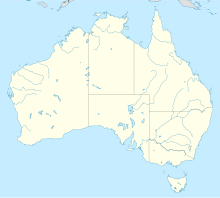
Mining is the extraction of valuable geological materials and minerals from the surface of the Earth. Mining is required to obtain most materials that cannot be grown through agricultural processes, or feasibly created artificially in a laboratory or factory. Ores recovered by mining include metals, coal, oil shale, gemstones, limestone, chalk, dimension stone, rock salt, potash, gravel, and clay. The ore must be a rock or mineral that contains valuable constituent, can be extracted or mined and sold for profit. Mining in a wider sense includes extraction of any non-renewable resource such as petroleum, natural gas, or even water.
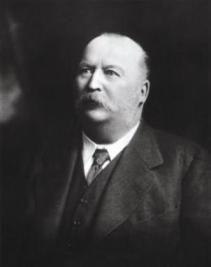
William Knox D'Arcy was a British-Australian businessman who was one of the principal founders of the oil and petrochemical industry in Persia (Iran). The D’Arcy Concession was signed in 1901 and allowed D'Arcy to explore, obtain, and market oil, natural gas, asphalt, and ozokerite in Persia.
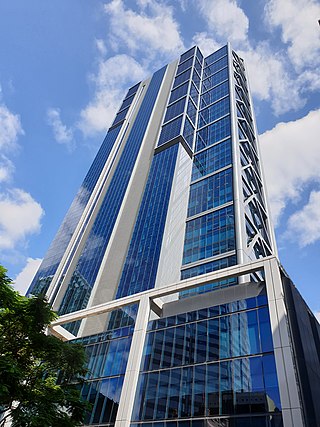
BHP Group Limited, formerly known as BHP Billiton, is an Australian multinational mining and metals public company headquartered in Melbourne, Australia.

Mount Morgan is a rural town and locality in the Rockhampton Region, Queensland, Australia. The town was the administrative centre of the Mount Morgan Shire until March 2008, when it was amalgamated with neighbouring local government areas to form the Rockhampton Region.
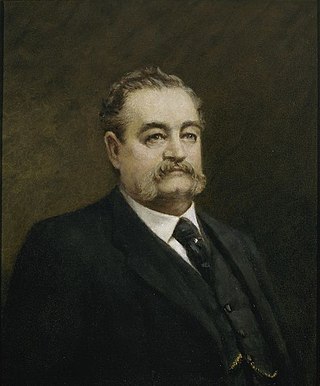
Walter Russell Hall was an Australian businessman and philanthropist.
Mount Isa Mines Limited ("MIM") operates the Mount Isa copper, lead, zinc and silver mines near Mount Isa, Queensland, Australia as part of the Glencore group of companies. For a brief period in 1980, MIM was Australia's largest company. It has pioneered several significant mining industry innovations, including the Isa Process copper refining technology, the Isasmelt smelting technology, and the IsaMill fine grinding technology, and it also commercialized the Jameson Cell column flotation technology.
The Pronto Mine is an historical uranium mine located approximately 20 km south of Elliot Lake, Ontario near Spragge. The site is owned and operated by Rio Algom Ltd, has been rehabilitated and is currently undergoing environmental monitoring.
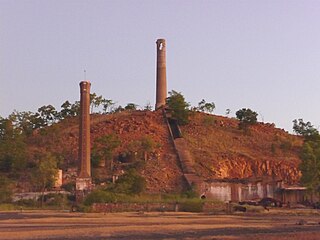
The Chillagoe smelters is a heritage-listed refinery at Chillagoe-Mungana Caves National Park, Mareeba Mining District, Chillagoe, Shire of Mareeba, Queensland, Australia. It operated in the early 1900s. It is also known as Chillagoe State Smelters. It was added to the Queensland Heritage Register on 21 October 1992.

St Mary's Anglican Church is a State heritage-listed church at 11 Gordon Street, Mount Morgan, Rockhampton Region, Queensland, Australia. It was designed and built in 1888–1889 by Scottish-born Thomas Glen Cornes (1842–1903), superintendent of sawmills and carpenters at the Mount Morgan Gold Mining Company Limited. It was added to the Queensland Heritage Register on 25 August 2000.

Adolphus William Copper Smelter is a heritage-listed former copper smelter and associated mining camp at Westwood and Oakey Creek in Rockhampton Region, Queensland, Australia. It was built in 1874. It was added to the Queensland Heritage Register on 13 May 2011.

OK Mine & Smelter is a heritage-listed mine at Kitoba Holding, Bellevue, Shire of Mareeba, Queensland, Australia. It was built from 1902 to 1942. It was added to the Queensland Heritage Register on 2 October 1996.

Tyrconnel Mine and Battery is a heritage-listed gold mine between Kingsborough and Thornborough, Shire of Mareeba, Queensland, Australia. It was built from 1876 to 1980s. It was added to the Queensland Heritage Register on 21 October 1992.
Einasleigh Copper Mine and Smelter is a heritage-listed mine at Daintree Road, Einasleigh, Shire of Etheridge, Queensland, Australia. It was built from 1867 to 1922. It is also known as Lynd Copper Mine and New Einasleigh Copper Mine. It was added to the Queensland Heritage Register on 11 December 2006.

Kuridala Township site is a heritage-listed mining camp in the locality of Kuridala, Shire of Cloncurry, Queensland, Australia. It was built from 1880s to 1920s. It is also known as Hampden Township, Hampden Smelter, Kuridala Smelter, and Friezeland Township. It was added to the Queensland Heritage Register on 12 June 2009.
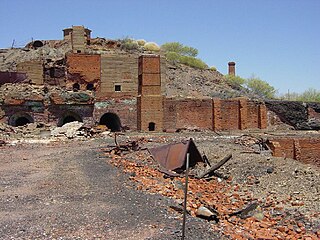
Mount Elliott Mining Complex is a heritage-listed copper mine and smelter at Selwyn, Shire of Cloncurry, Queensland, Australia. It was designed by William Henry Corbould and built in 1908. It is also known as Mount Elliott Smelter and Selwyn. It was added to the Queensland Heritage Register on 16 September 2011. See also Mount Elliott Company Metallurgical Plant and Mill and Mount Elliott mine.

Mount Morgan State High School is a heritage-listed state high school and technical college at 4 Central Street, Mount Morgan, Rockhampton Region, Queensland, Australia. It was built in 1908. It was formerly known as Mount Morgan Technical College. It was added to the Queensland Heritage Register on 4 December 2015.

ABC Radio Studios are heritage-listed radio studios at 236 Quay Street, Rockhampton City, Rockhampton, Rockhampton Region, Queensland, Australia. It was added to the Australian Commonwealth Heritage List on 14 September 2009.
Thomas Skarratt Hall was a British bank manager and mine director in Rockhampton, Queensland, Australia.
Coldstream Copper Mine, sometimes called the North Coldstream Copper Mine, the Coldstream Mine, or the North Coldstream Mine is a decommissioned former copper, silver and gold mine adjacent to Burchell Lake. It is located 11km south of Kashabowie, in Northern Ontario, Canada.

Great Cobar mine was a copper mine, located at Cobar, New South Wales, Australia, which also produced significant amounts of gold and silver. It operated between 1871 and 1919. Over that period, it was operated by five entities; Cobar Copper Mining Company (1871-1875), Great Cobar Copper-Mining Company (1876-1889), Great Cobar Mining Syndicate (1894-1906), Great Cobar Limited (1906-1914), and finally the receiver representing the debentures holders of Great Cobar Limited (1915-1919). Its operations included mines and smelters, at Cobar, an electrolytic copper refinery, coal mine and coke works, at Lithgow, and a coal mine and coke works at Rix's Creek near Singleton.

